US Engineering, Procurement, And Construction Management (EPCM) Market Size
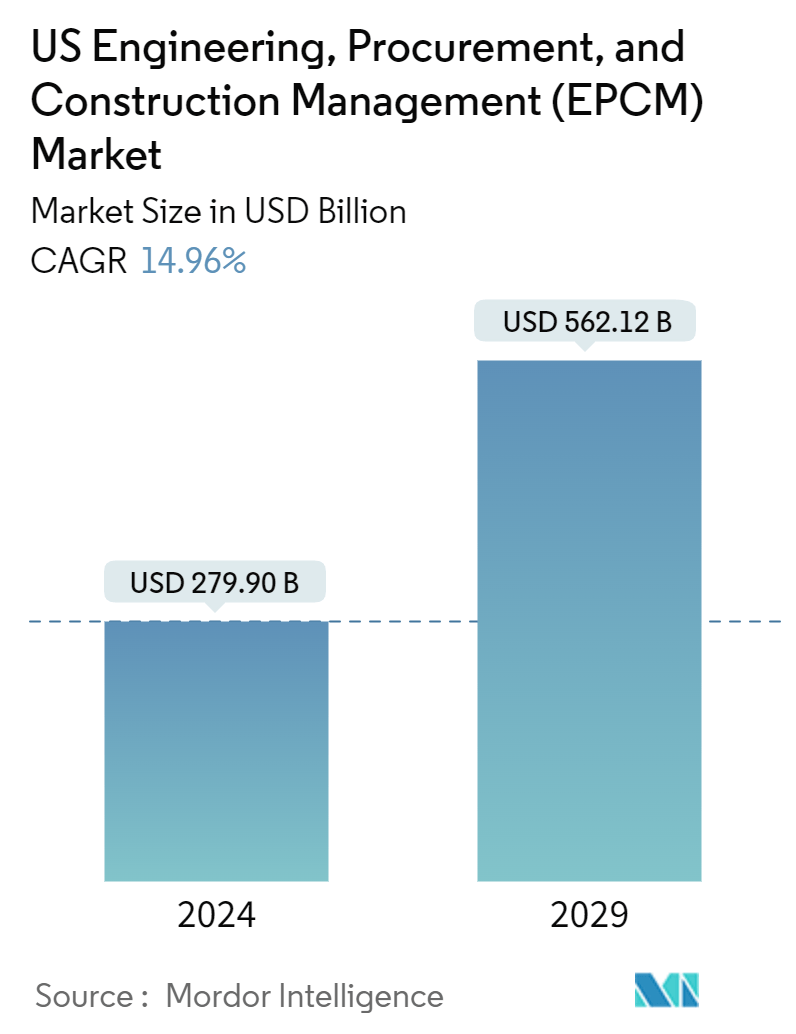
| Study Period | 2024 - 2029 |
| Base Year For Estimation | 2023 |
| Market Size (2024) | USD 279.90 Billion |
| Market Size (2029) | USD 562.12 Billion |
| CAGR (2024 - 2029) | 14.96 % |
| Market Concentration | Medium |
Major Players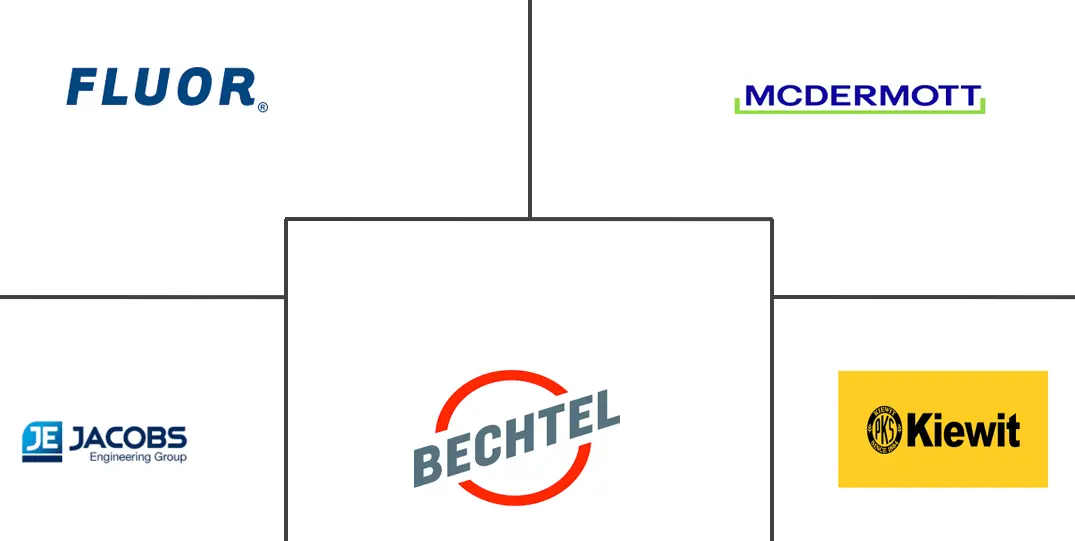
*Disclaimer: Major Players sorted in no particular order |
US Engineering, Procurement, And Construction Management (EPCM) Market Analysis
The US Engineering, Procurement, And Construction Management Market size is estimated at USD 279.90 billion in 2024, and is expected to reach USD 562.12 billion by 2029, growing at a CAGR of 14.96% during the forecast period (2024-2029).
The engineering, procurement, and construction management (EPCM) market in the United States plays a pivotal role in the nation's infrastructure and industrial landscape. It boasts multi-billion dollar revenues and a consistent growth trajectory, primarily fueled by substantial investments in infrastructure upgrades, renewable energy ventures, and industrial expansions. Notably, government initiatives, exemplified by the Infrastructure Investment and Jobs Act, channel significant capital into transportation, utilities, and the burgeoning smart city sector. Furthermore, the nation's pivot toward sustainable energy, encompassing wind, solar, and energy storage, bolsters the project pipeline for EPC firms. This momentum is further fueled by the imperative for modernizing manufacturing plants and the expanding need for healthcare and data center infrastructure.
Despite its promising outlook, the US EPC market grapples with challenges that could impede its growth. Regulatory intricacies, labor scarcities, escalating material prices, and inflationary pressures pose notable hurdles. However, amid these obstacles, the market presents a range of opportunities, especially in the realms of smart infrastructure, renewable energy, and cutting-edge manufacturing. Noteworthy industry players like Bechtel, Fluor, and Jacobs Engineering are at the forefront, harnessing technologies like building information modeling (BIM), IoT, and AI to elevate project efficiency and sustainability. Therefore, the US EPC market is poised for further expansion, buoyed by governmental backing, technological strides, and an escalating appetite for contemporary infrastructure.
US Engineering, Procurement, And Construction Management (EPCM) Market Trends
Investments in Infrastructure are Poised to Propel the EPCM Sector
Infrastructure investment in the United States, especially in the engineering, procurement, and construction (EPC) sector, is pivotal for economic growth and modernization. The country is channeling significant funds into enhancing transportation networks, public utilities, and other crucial infrastructure to keep pace with a growing population and advancing technology.
In 2023, the President and Transportation Secretary unveiled that the Biden-Harris Administration had allocated nearly USD 1.2 billion from the new National Infrastructure Project Assistance (Mega) discretionary grant program to nine national projects. These initiatives aim to bolster the economy, create well-paying jobs, fortify supply chains, enhance resident mobility, and elevate the safety of the transportation systems.
The Mega grant initiative, a product of President Biden's landmark infrastructure legislation, is tailored for projects that outstrip conventional funding programs in scale or complexity. Eligible ventures include highways, bridges, ports, and public transportation.
By 2026, the Mega program is expected to infuse a total of USD 5 billion into revamping the US infrastructure, with a focus on benefiting current and future generations. In the latest application round, the US Department of Transportation fielded requests totaling around USD 30 billion, far surpassing the available USD 1 billion in 2022. Notable projects include:
USD 292 million for Hudson Yards Concrete Casing, Section 3 (New York): This funding will complete the final section of the concrete casing, securing the right-of-way for the new Hudson River Tunnel and setting the stage for the Gateway Project. The Hudson Tunnel initiative, upon fruition, promises improved commute times, enhanced Amtrak reliability on the Northeast Corridor (NEC), and a boost to the regional economy, which houses 17% of the US population. Amtrak anticipates the project will create 72,000 jobs during construction, with a focus on union partnerships for job training.
USD 250 million for Brent Spence Bridge improvements (Cincinnati, OH, and Covington, KY): This vital freight corridor, spanning the Ohio River, witnesses over USD 400 billion in annual freight movement and is notorious for its truck bottlenecks. The Mega grant will facilitate essential upgrades to the Brent Spence Bridge and the construction of a new bridge alongside the existing one, aimed at alleviating congestion and enhancing travel time reliability, thus bolstering the regional economy.
Overall, infrastructure investment in the United States, especially in the EPC sector, is pivotal in driving economic growth and modernization. The Biden-Harris Administration's commitment is evident in allocating nearly USD 1.2 billion from the National Infrastructure Project Assistance (Mega) discretionary grant program. Noteworthy projects like the Hudson River Tunnel and Brent Spence Bridge highlight the administration's focus on bolstering transportation networks, job creation, and supply chain resilience. With the Mega program eyeing a USD 5 billion investment by 2026, the nation is poised to witness enhanced mobility, safety, and economic robustness, benefiting current and future generations.
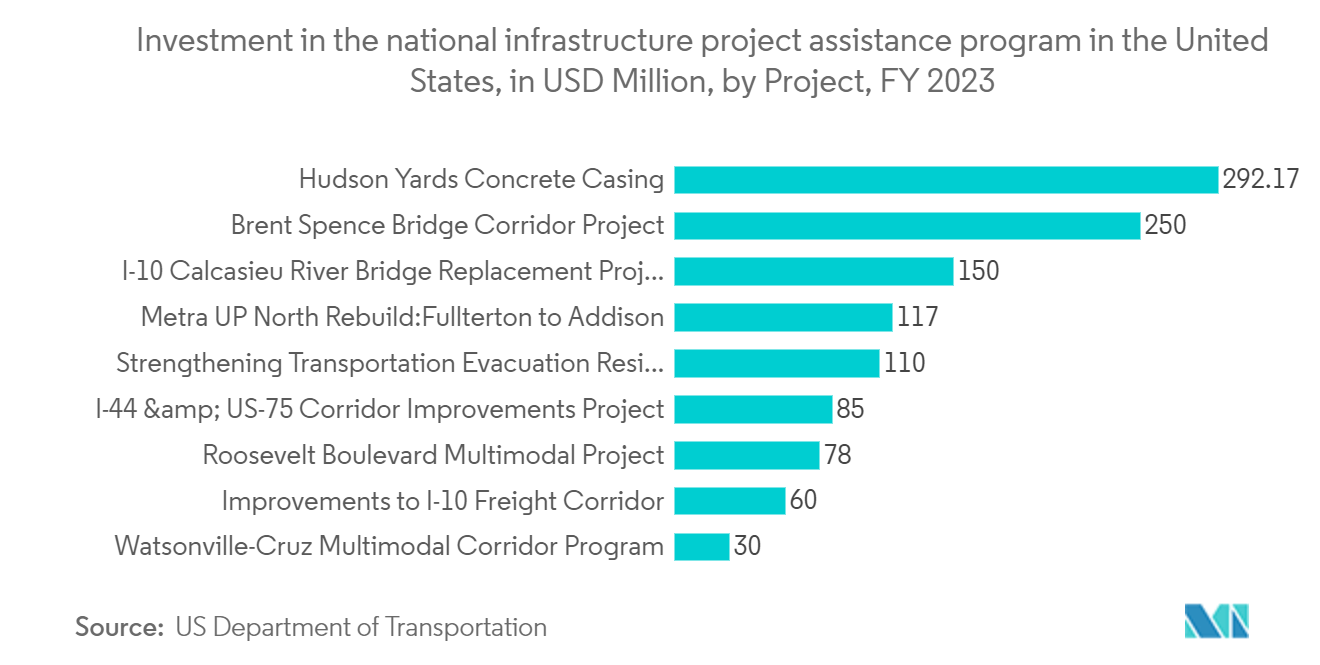
The Power and Utilities Sector is Experiencing a Surge in Demand
In 2023, the US power and utilities sector significantly advanced its decarbonization efforts, achieving record solar and energy storage installations. This progress, bolstered by pivotal clean energy and climate legislation, continued into 2024. While the sector's fundamentals were a mixed bag, electricity sales were forecasted to dip by approximately 1.2% YoY by the end of 2023, primarily due to a mild winter. Supply chain challenges began to ease, yet persistent shortages of key materials like steel and transformers disrupted operations and drove up costs.
Many regions saw a drop in wholesale electricity prices, largely attributed to a 53% YoY decrease in natural gas costs for power generation in 2023. However, since not all utilities procure electricity from wholesale markets and fuel expenses are just one component of customer bills, the correlation with price movements may not be direct. In 2023, major electric and gas utilities collectively spent nearly USD 171 billion on grid modernization and decarbonization, setting a new record. Coupled with anticipated future spending and rising interest rates, these high capital outlays could translate to increased customer bills.
In 2024, electricity prices are anticipated to hold steady, while sales are projected to increase by around 2%. Supply chain disruptions are expected to resolve gradually. The momentum for clean energy initiatives, supported by various catalysts, is likely to persist. A growing number of US electric firms have accelerated their carbon reduction targets, aiming for an 80% cut by 2030, shifting from the previous "net zero by 2050" goal. By August 2023, on the first anniversary of the Inflation Reduction Act (IRA), investors had already earmarked over USD 122 billion for clean energy generation and an additional USD 110 billion for bolstering domestic clean energy manufacturing.
In 2023, the Infrastructure Investment and Jobs Act (IIJA) allocated billions for enhancing grid reliability, battery supply chains, EV programs, and energy efficiency. The US Energy Information Administration (EIA) expected a significant surge in utility-scale solar installations of more than doubling to 24 gigawatts in 2023, followed by an additional 36 GW in 2024. Its projections also indicated a rise in the renewable electricity share from 22% in 2023 to nearly 25% in 2024.
Overall, the US power and utilities sector made significant strides in decarbonization and clean energy adoption, supported by substantial legislative backing and record investments. Despite facing supply chain challenges and a forecasted dip in electricity sales, the sector is poised for steady electricity prices and increased sales in 2024, with continued momentum toward ambitious carbon reduction goals.
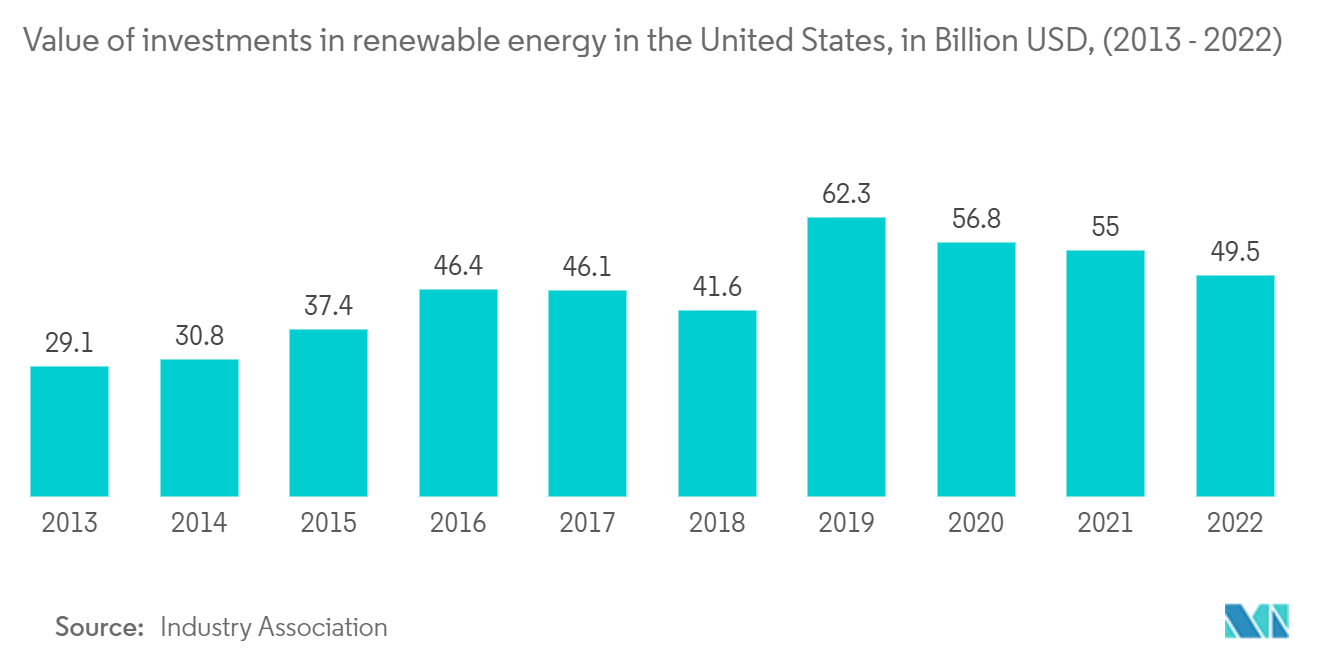
US Engineering, Procurement, And Construction Management (EPCM) Industry Overview
The US EPCM market exhibits moderate market concentration, driven by the presence of several large multinational firms and significant merger and acquisition activities. The competitive landscape is dynamic, with ongoing technological advancements and government policies shaping the market structure. Prominent entities in this sector include Fluor Corporation, McDermott International Ltd, Jacobs Engineering Group, Bechtel Corporation, and Kiewit Corporation.
US Engineering, Procurement, And Construction Management (EPCM) Market Leaders
-
Fluor Corporation
-
McDermott International, Ltd,
-
Jacobs Engineering Group
-
Bechtel Corporation
-
Kiewit Corporation
*Disclaimer: Major Players sorted in no particular order
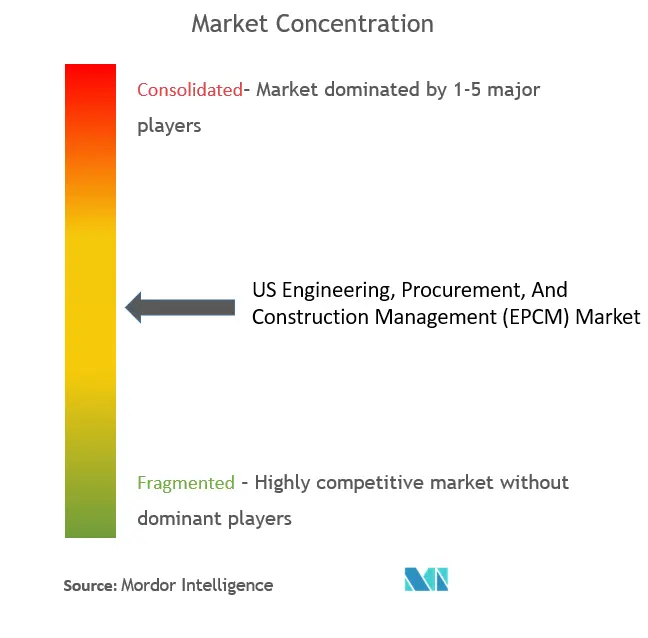
US Engineering, Procurement, And Construction Management (EPCM) Market News
August 2023: USA Rare Earth LLC (USARE), a leading magnet technology firm, unveiled a pivotal collaboration with Hatch, a renowned global engineering entity. Hatch, recognized for its engineering, procurement, and construction management prowess, spearheaded USARE initiatives alongside a significant financial commitment to the venture. USARE's bold vision involved overhauling a sintered magnet production site in Stillwater, Oklahoma, and establishing an extraction and separation facility in Sierra Blanca, Texas. These endeavors were strategically crafted to elevate USARE as the foremost mine-to-magnet producer in the United States.
April 2023: The US administration's Federal Sustainability Plan mandated that all federal agencies shift to light-duty electric vehicles by 2027 and heavy-duty zero-emission vehicles by 2035. The US Department of Transportation will collaborate with states and local governments to establish a national network of 500,000 publicly accessible EV charging stations by 2030. According to the Federal Highway Administration, the United States boasts 160,000 active public EV chargers. To put this in perspective, the country has approximately 145,000 gasoline stations. Notably, USD 2 billion from the 2022 Inflation Reduction Act was allocated to support the development of new EV production facilities.
May 2022: Technip Energies (PARIS: TE), in consortium with Saulsbury Industries, was awarded a contract for the engineering, procurement, and construction (EPC) to expand the carbon capture and storage (CCS) at ExxonMobil’s LaBarge, Wyoming, facility. The LaBarge plant had already captured more CO2 than any other facility worldwide. The plant can capture more than 6 million metric tons per year, and this expansion project enabled the capture of more than 1 million additional metric tons of CO2 annually.
US Engineering, Procurement, And Construction Management (EPCM) Market Report - Table of Contents
1. INTRODUCTION
- 1.1 Study Deliverables
- 1.2 Study Assumptions
- 1.3 Scope of the Study
2. RESEARCH METHODOLOGY
3. EXECUTIVE SUMMARY
4. MARKET DYNAMICS
- 4.1 Market Overview
-
4.2 Market Drivers
- 4.2.1 Infrastructure Modernization and Development
- 4.2.2 Increase in Emphasis on Sustainability in the Construction Industry
-
4.3 Market Restraints
- 4.3.1 Skilled Workforce Availability
- 4.3.2 Rising Material Costs
-
4.4 Market Opportunities
- 4.4.1 Increasing Investments in Wind and Solar Energy Projects
- 4.5 Value Chain / Supply Chain Analysis
-
4.6 Porter's Five Forces Analysis
- 4.6.1 Threat of New Entrants
- 4.6.2 Bargaining Power of Buyers/Consumers
- 4.6.3 Bargaining Power of Suppliers
- 4.6.4 Threat of Substitute Products
- 4.6.5 Intensity of Competitive Rivalry
- 4.7 PESTLE Analysis
- 4.8 Insights on Technology Innovation in the Market
5. MARKET SEGMENTATION
-
5.1 By Service
- 5.1.1 Engineering
- 5.1.2 Procurement
- 5.1.3 Construction
- 5.1.4 Other Services
-
5.2 By Sector
- 5.2.1 Residential Industrial, Infrastructure (Transportation), and Energy and Utilities
- 5.2.2 Industrial
- 5.2.3 Infrastructure (Transportation)
- 5.2.4 Energy and Utilities
6. COMPETITIVE LANDSCAPE
- 6.1 Market Concetration Overview
-
6.2 Company Profiles
- 6.2.1 Fluor Corporation
- 6.2.2 McDermott International Ltd
- 6.2.3 Jacobs Engineering Group
- 6.2.4 Bechtel Corporation
- 6.2.5 Kiewit Corporation
- 6.2.6 AECOM
- 6.2.7 Black & Veatch
- 6.2.8 Burns & McDonnell
- 6.2.9 Turner Construction
- 6.2.10 The Walsh Group Ltd
- *List Not Exhaustive
7. FUTURE TRENDS
** Subject To AvailablityUS Engineering, Procurement, And Construction Management (EPCM) Industry Segmentation
The engineering, procurement, and construction management (EPCM) market offers services encompassing diverse industries' project planning, design, procurement, construction, and management.
The US engineering, procurement, and construction management (EPCM) market is segmented by service (engineering, procurement, construction, and other services) and sector (residential, commercial, industrial, infrastructure [transportation], and energy and utilities). The report offers market size forecasts for the engineering, procurement, and construction management (EPCM) market in value (USD) for all the above segments.
US Engineering, Procurement, And Construction Management (EPCM) Market Research FAQs
How big is the US Engineering, Procurement, And Construction Management Market?
The US Engineering, Procurement, And Construction Management Market size is expected to reach USD 279.90 billion in 2024 and grow at a CAGR of 14.96% to reach USD 562.12 billion by 2029.
What is the current US Engineering, Procurement, And Construction Management Market size?
In 2024, the US Engineering, Procurement, And Construction Management Market size is expected to reach USD 279.90 billion.
Who are the key players in US Engineering, Procurement, And Construction Management Market?
Fluor Corporation, McDermott International, Ltd,, Jacobs Engineering Group, Bechtel Corporation and Kiewit Corporation are the major companies operating in the US Engineering, Procurement, And Construction Management Market.
What years does this US Engineering, Procurement, And Construction Management Market cover, and what was the market size in 2023?
In 2023, the US Engineering, Procurement, And Construction Management Market size was estimated at USD 238.03 billion. The report covers the US Engineering, Procurement, And Construction Management Market historical market size for years: . The report also forecasts the US Engineering, Procurement, And Construction Management Market size for years: 2024, 2025, 2026, 2027, 2028 and 2029.
US Engineering, Procurement, And Construction Management (EPCM) Industry Report
Statistics for the 2024 US Engineering, Procurement, And Construction Management (EPCM) market share, size and revenue growth rate, created by Mordor Intelligence™ Industry Reports. US Engineering, Procurement, And Construction Management (EPCM) analysis includes a market forecast outlook for 2024 to 2029 and historical overview. Get a sample of this industry analysis as a free report PDF download.
US Engineering, Procurement, And Construction Management (EPCM) Market Report Snapshots
- US Engineering, Procurement, And Construction Management (EPCM) Market Size
- US Engineering, Procurement, And Construction Management (EPCM) Market Share
- US Engineering, Procurement, And Construction Management (EPCM) Market Trends
- US Engineering, Procurement, And Construction Management (EPCM) Companies



